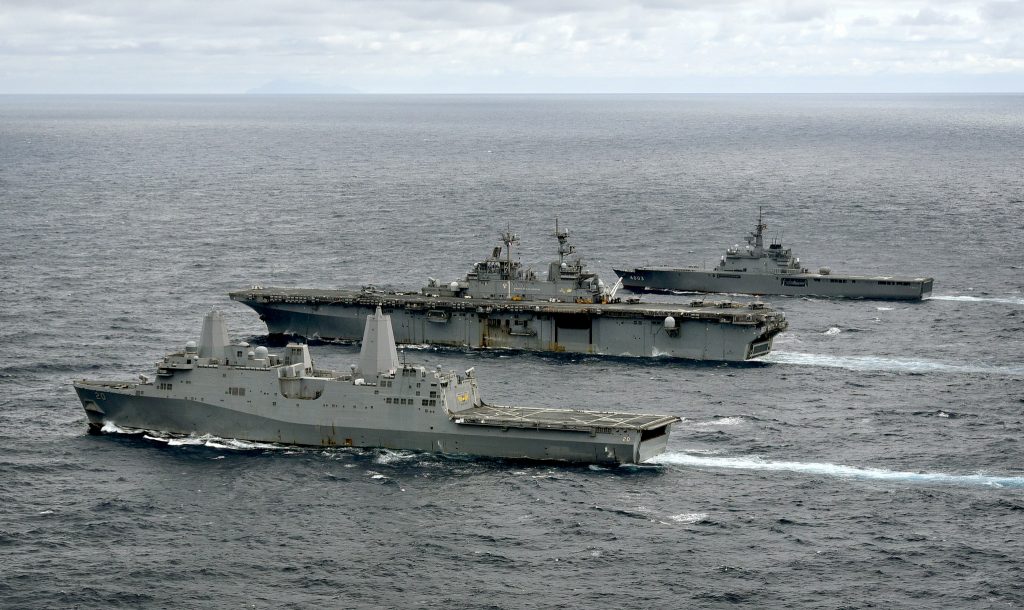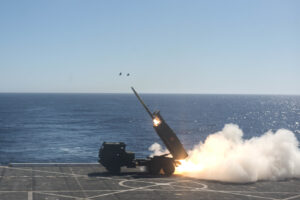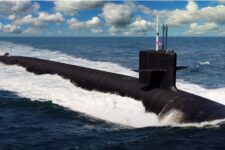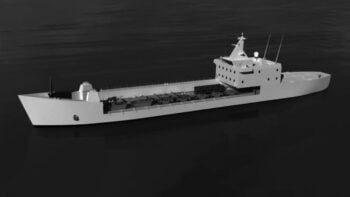
The amphibious ships USS Green Bay, USS Wasp, and Japanese amphibious transport JS Kunisaki in the East China Sea.
CAPITOL HILL: Threatened by hundreds of precision-guided munitions now in the hands of Russia and China, the Navy and Marine Corps continue to search for technologies and tactics that will allow them to operate close to the coastline without unsustainable losses.
“We’re going to need long-range fires that can operate from a ship or from the shore to take out sea-based or shore-based platforms” Lt. Gen. David Berger, the head of the Corps’ combat development office, told a group of industry execs and lawmakers on Capitol Hill Thursday.
Speaking at an Amphibious Warship Industrial Base Coalition breakfast here, Berger warned that in the near future, “we’re going to have to fight to get to the fight. Nothing is sacred and nothing is protected.”
The Navy has been wrestling with the thorny problem of area denial, particularly in the Western Pacific and tighter spaces like the Black and Baltic seas, where China and Russia have deployed a host of radar, mid-and long-range missiles — in addition to modernized surface ships and submarines — to keep American ships away from the littorals.
The Navy’s amphibious ships are particularly at risk, as they are lightly armed and designed to transport Marines, helicopters, and supplies close to shore.

Marines from the 31st Marine Expeditionary Unit maneuver amphibious assault vehicles near the Whidbey Island-class amphibious dock landing ship USS Germantown.
The Marines have for several years called for the Navy’s 32 amphibious ships to be outfitted with Vertical Launch System cells or other weapons that would give them a fighting chance in the littorals. But, as Breaking Defense reported last month, Navy officials say that’s not going to happen, at least in the short-term.
But that didn’t stop Berger from pushing forward with the idea. “We have to increase the lethality of the ships,” he said. “The ships are not [just] lift. They are a warfighting platform.”
At the same time the Marines are pushing for more firepower, they also want the ships to be more networked with air and land assets, as Pentagon leadership moves forward with its Multi-Domain Operations concept. “We have to upgrade the command and control systems because this is part of a joint construct,” Berger said. “Moving information and closing the targeting loop is what we have to do. Vertical launching systems or some other way to make an amphibious ship more lethal is absolutely necessary.”
The Marines have already been kicking the tires on some innovative ways to send enemy ships to the bottom.
Breaking Defense recently learned that the service has kicked off a rapid development program to begin firing long-range anti-ship missiles from shore-based ground vehicles. Dubbed the Navy-Marine Expeditionary Ship Interdiction System — or NEMSIS — the program has completed its design phase. The Marines are looking at Lockheed Martin’s new Long-Range Anti-Ship Missile (LRASM), Raytheon’s Naval Strike Missile, and Boeing’s venerable Harpoon.

A Marine HIMARS missile launcher fires from the deck of the USS Anchorage.
Rep. Mike Gallagher, a former Marine officer who also spoke at Thursday’s event, told the military and industry leaders that the Navy needs to think differently about lethality now that its ships can be ranged by enemy missiles are greater distances.
The Mk 6 patrol boat, deployable from the well decks of amphibious ships, are a good place to look for innovation he said. The small, highly maneuverable vessels can be outfitted with the LRASM, he suggested, “so you can imagine using amphibs as a mother ship, you can imagine parking patrol boats armed with LRASMs in disputed or strategic areas where they provide near-constant presence. The point is, it’s going to be up to our nation’s amphibious force to deliver outside-the-box solutions like this.”
The idea of getting anywhere close to enemy shorelines might be one whose time has come and gone, however. A new report from the Center for Strategic and Budgetary Assessments estimates that American big-deck aircraft carriers are likely to have to stay at least 1,000 miles away from the coast in order to protect themselves from precision missile salvos and new generations of aircraft.
“If the U.S. Navy is going to continue to invest in aircraft carriers, it need to re-consider how it’s going to configure its [carrier] air wings,” said Bryan Clark, a CSBA senior fellow. His report calls for a uptick in investments in unmanned air, surface, and undersea platforms that can act as picket lines for a carrier strike group, while manned aircraft act as “pouncers” to quickly hit enemy ships or subs once detected by the unmanned assets.
Current carriers are “not designed for the way we’re going to operate in the future,” Clark said on Thursday. “I would even go further to say, unless the Navy is going to re-configure its air wings, it should reconsider its continued investment in aircraft carriers.”
‘Mind-boggling’: Israel, Ukraine are mere previews of a much larger Pacific missile war, officials warn
MDA Chief Lt. Gen. Heath Collins said more maneuverable missiles and drones have changed the missile defense game: Instead of just preparing to hit “fastballs,” he said, “now we’re hitting sliders and curveballs.”



























